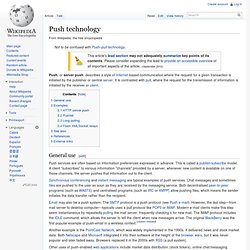

Continuations - Jetty. Icon Continuations will be replaced by standard Servlet-3.0 suspendable requests once the specification is finalized.

Early releases of Jetty-7 are now available that implement the proposed standard suspend/resume API With most web applications today, the number of simultaneous users can greatly exceed the number of connections to the server. Asynchronous HTTP and Comet architectures. Comet has popularized asynchronous non-blocking HTTP programming, making it practically indistinguishable from reverse Ajax, also known as server push.

In this article, Gregor Roth takes a wider view of asynchronous HTTP, explaining its role in developing high-performance HTTP proxies and non-blocking HTTP clients, as well as the long-lived HTTP connections associated with Comet. He also discusses some of the challenges inherent in the current Java Servlet API 2.5 and describes the respective workarounds deployed by two popular servlet containers, Jetty and Tomcat.
While Ajax is a popular solution for dynamically pulling data requests from the server, it does nothing to help us push data to the client. In the case of a Web mail application, for instance, Ajax would enable the client to pull mails from the server, but it would not allow the server to dynamically update the mail client. Push technology. General use[edit] Push services are often based on information preferences expressed in advance.

This is called a publish/subscribe model. A client "subscribes" to various information "channels" provided by a server; whenever new content is available on one of those channels, the server pushes that information out to the client. Synchronous conferencing and instant messaging are typical examples of push services. Chat messages and sometimes files are pushed to the user as soon as they are received by the messaging service.